
Similar to Inside the Strategy Room
1 The McKinsey Podcast
Mckinsey & company, 1 take on tomorrow, 1 what's next with tiffani bova, tiffani bova, 1 the entreleadership podcast, ramsey network, 1 outsource accelerator podcast with derek gallimore, derek gallimore, 1 play to potential podcast, play to potential podcast, 1 marketing against the grain, hubspot podcast network, 1 knowledge at wharton, knowledge at wharton, 1 radio advisory, advisory board, 1 the kara goldin show, kara goldin, podcasts worth a listen, inside the strategy room « » 98. agile business portfolio management.
In business, breaking up is hard to do. While divesting businesses in a timely manner is an essential aspect of effective portfolio management, companies tend to struggle with separation decisions. In this episode, three experts discuss how to determine which businesses to strengthen and which to divest and explain how to make your M&A strategy nimble enough to keep up with increasingly dynamic markets. Obi Ezekoye, a leader in the Strategy and Corporate Finance practice, and Anthony Luu, an expert in M&A and strategy transformations, are co-authors of a recent article, “Divesting with Agility .” They are joined by Andy West, the global co-leader of McKinsey’s M&A practice and co-author of ‘ Why you’ve got to put your portfolio on the move .’
Join 90,000 other members of our LinkedIn community: https://www.linkedin.com/showcase/mckinsey-strategy-&-corporate-finance/
See www.mckinsey.com/privacy-policy for privacy information
275 episodes
98. Agile business portfolio management
Inside the Strategy Room
244 subscribers
published 2+ y ago
All episodes
Welcome to player fm.
Player FM is scanning the web for high-quality podcasts for you to enjoy right now. It's the best podcast app and works on Android, iPhone, and the web. Signup to sync subscriptions across devices.
Quick Reference Guide

Agile Portfolio Management - Bringing Agility at a Global Level
Agile portfolio management is about bringing transparency and connecting strategy to project execution. Read along to explore the specifics of this management approach and how it differs from traditional portfolio management.
- Agile Project Management Principles
- Building an Agile Workflow
- What Is Agile Planning?
- Agile Implementation
- Agile Metrics
- Structuring Work with Agile
- Agile Retrospective
- Agile Epics
- Agile User Stories
- Agile Estimation
- Agile Reporting
- Agile Ceremonies
- Benefits of Agile Project Management
- Agile Best Practices
- Top Agile PM Tools
- Agile vs. Waterfall
- Agile Terms
- Different Agile Methodologies
- Agile Teams
- Agile Organization
- Operational Agility
- Organizational Agility
Agile Portfolio Management
Lean Portfolio Management
Agile Scaling Frameworks
- Agile in Engineering
- Agile in Construction
- Agile in Aerospace
- Agile in Automotive
- Agile in Pharma
- Agile Transformation Roadmap
- Enterprise Agile Transformation
- Agile Mindset
- Digital Transformation Strategy
- Digital Transformation Benefits
- Digital Transformation Examples
- Business Agility Transformation
- Business Agility Assessment
- Business Agility Examples
What Is an Agile Portfolio Management?
Agile portfolio management refers to applying Agile principles and practices to manage a portfolio of projects . It involves aligning strategy and execution, improving transparency across a portfolio of projects, and embracing cross-team collaboration and continuous improvement.
Adopting Agile principles to portfolio management has been a trend for the past years since the increasing popularity of the Agile way of working. As more and more companies from all business sectors realize the effectiveness of Agile practices, they are looking to spread them across different organizational levels, not just on a team level.
In the following paragraphs, we will explore:
- how Agile portfolio management differs from the traditional approach of managing work;
- what the concept of managing an Agile portfolio entails;
- and how to implement it in practice.
Traditional vs. Agile Portfolio Management
To begin with, let’s first clarify what exactly a portfolio is. By definition, a portfolio usually represents a collection of projects, products, investments, programs, etc., in a single business unit inside the organization. In turn, the process of managing that portfolio is all about identifying projects for execution and prioritizing them to ensure that the right things are done at the right time.
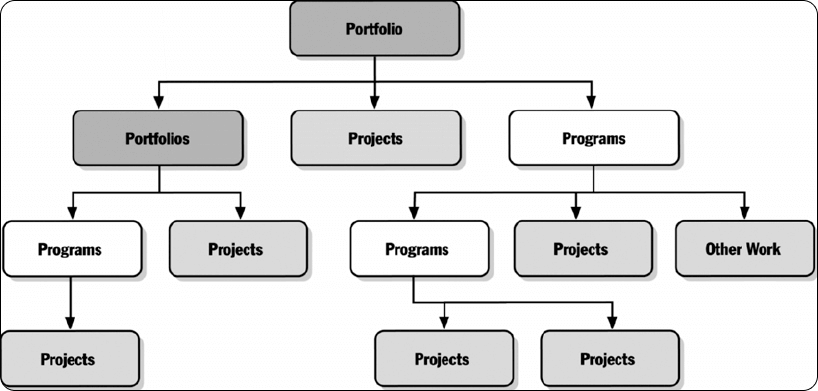
Let's find out how this is handled by different management approaches.
Traditional Portfolio Management
Traditionally, portfolio prioritization happens by planning a detailed project roadmap and then applying budgets based on those plans. Once funding is approved, the portfolio is implemented. The approach requires heavy upfront planning for the projects to be approved, and in today's highly volatile business environment, it’s risky to rely on that. Despite this, many organizations try to start as many projects as possible at once, which has its downsides.
When too many projects are in progress, teams get easily overburdened by switching between many priorities, resulting in low productivity. Low transparency of the management process is another threat, which can also lead to misalignment between the company's strategy and its execution.
To deal with the challenges in the face of the traditional approach, the Agile portfolio management process applies the “test, learn and adapt” principles and decentralized control on a portfolio level. Identifying priorities in Agile, for instance, happens through rapid feedback loops. Portfolio managers regularly review a particular set of projects and assess how they align with the strategic initiatives. They also frequently engage in collaborative discussions with project managers or different team leaders to identify small experiments to evaluate projects or improve a given product/service delivery. This allows them to gather fast feedback and make data-driven decisions. Moreover, instead of preparing highly detailed project roadmaps to apply for budgets, Agile portfolio management entails planning on multiple levels and cascading power downwards . In turn, financial resources are allocated towards experiments and value streams within the organization rather than separate projects.

While the traditional portfolio management approach supports planning in advance and strict budget allocation, the Agile way of managing a portfolio of projects promotes flexibility. This Agile planning enables portfolio managers to reallocate funds to emerging priorities based on changing customer requirements or new ideas that can be more valuable than the old ones.
Main Pillars of Agile Portfolio Management
To sustain agility within their operations, Agile organizations:
- focus on maintaining transparency,
- continuously experiment to determine whether a project is valuable, and
- align strategy with execution.
Combined, these goals form Agile portfolio management's three main pillars. Let's break them down and briefly discuss each one of them below.
1. Scaled Transparency
Creating transparency in the portfolio and overall project management processes is critical in today's rapidly changing business environment. Traditionally, there is a big emphasis on detailed status reporting performed by portfolio or project managers. The problem is that this takes a lot of valuable time, and often the reporting turns out to be wrong because it's reliant on flawed estimations. Agile, in turn, focuses on creating a shared purpose for everyone to follow both from a strategic and project management point of view. By implementing connected visual boards, portfolio managers can easily capture ideas for multiple projects and create a shared understanding of what's happening inside the portfolio. The desired outcome is to establish an open environment where all concerned parties can quickly check the status of a project and thus reduce the need for preparing extensive reports.
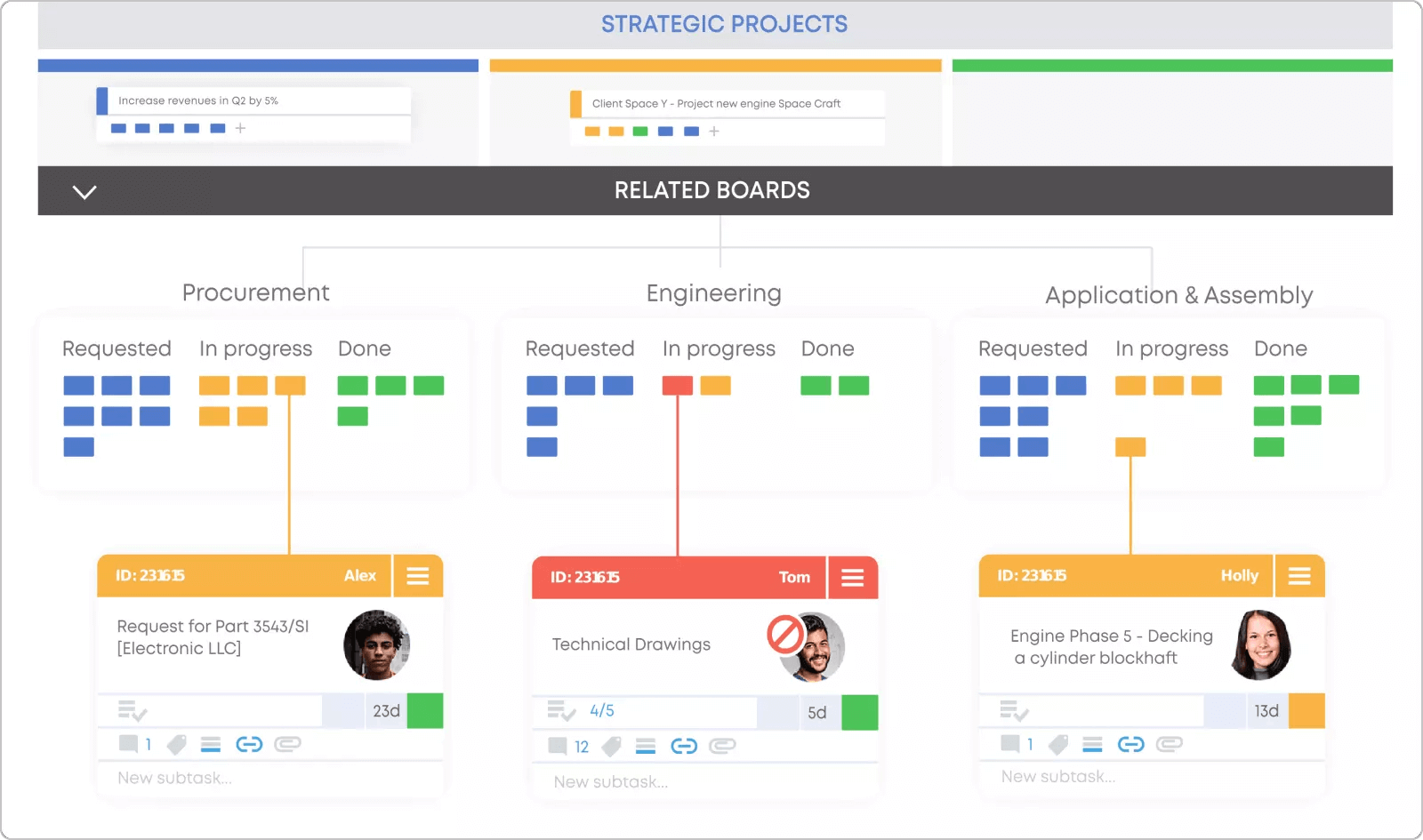
Furthermore, rather than estimating based on gut feeling, Agile promotes forecasting project plans that the teams progressively refine. The idea is to take actual data into account and retain the flexibility to update the plans based on new information.
2. Continuous Experimentation & Agile Portfolio Prioritization
When having a set of project ideas, it may be challenging to determine which ones are more important than others at a given moment. A bad practice would be to start working on all of them, as the chance of overloading your teams is high, and the risk of project failure increases. To prevent that, you need to learn how to pick only the most valuable ones and prioritize them accordingly. Here comes the concept of rapid experimentation that is central in an Agile environment. To determine whether a given project is worth pursuing, you can run small experiments as part of its validation process. The idea is to quickly gather data before rushing to make any big commitments , only to find out that the chosen project will not bring the expected value. Other than that, it's not uncommon to end up with a bunch of validated projects which are all highly valuable. How do you decide which one of them to execute first then? For that, you can use the powerful concept of cost of delay (CoD) to make sequencing decisions. It's based on pure economics and shows how much money you would lose if you delayed project delivery. So, as a rule of thumb, the higher the cost of delay, the higher the priority of a given project. In case two or more projects have the same cost of delay, you should start with the shortest one. However, keep in mind that you should use the cost of delay as an input to other variables (such as market and technical risks) rather than a "one-size-fits-all" solution.
3. Aligning Strategy and Execution
Another central pillar of Agile portfolio management is achieving alignment between strategy and execution , where the portfolio connects the two.
Therefore, effective portfolio management requires a way to align the highest business objectives with the project execution . To do this in practice, the Agile culture promotes frequent feedback loops that can be applied globally (across the company's management) and locally (across teams). You can review strategy, project risks, and delivery capabilities by creating a network of these short planning and learning cycles on multiple organizational levels. This allows you to quickly adapt to high-level changes and shift your operations towards the most critical priority whenever necessary.
How to Manage an Agile Portfolio in Practice?
To create an Agile portfolio management process in reality, you need a complete management system to visualize, prioritize, and align your portfolio projects with the company's strategic initiatives. This is where the workflow management method Kanban steps in to help you put theory into practice.
Apply Kanban at the Portfolio Level
Kanban’s primary focus is on visualization, limiting work in progress, managing flow, and continuous improvement. These can be applied on multiple levels inside the company, including the portfolio. This is done through the concept of Portfolio Kanban , which allows you to track and optimize the flow of different business initiatives, single or multiple projects, or entire products.
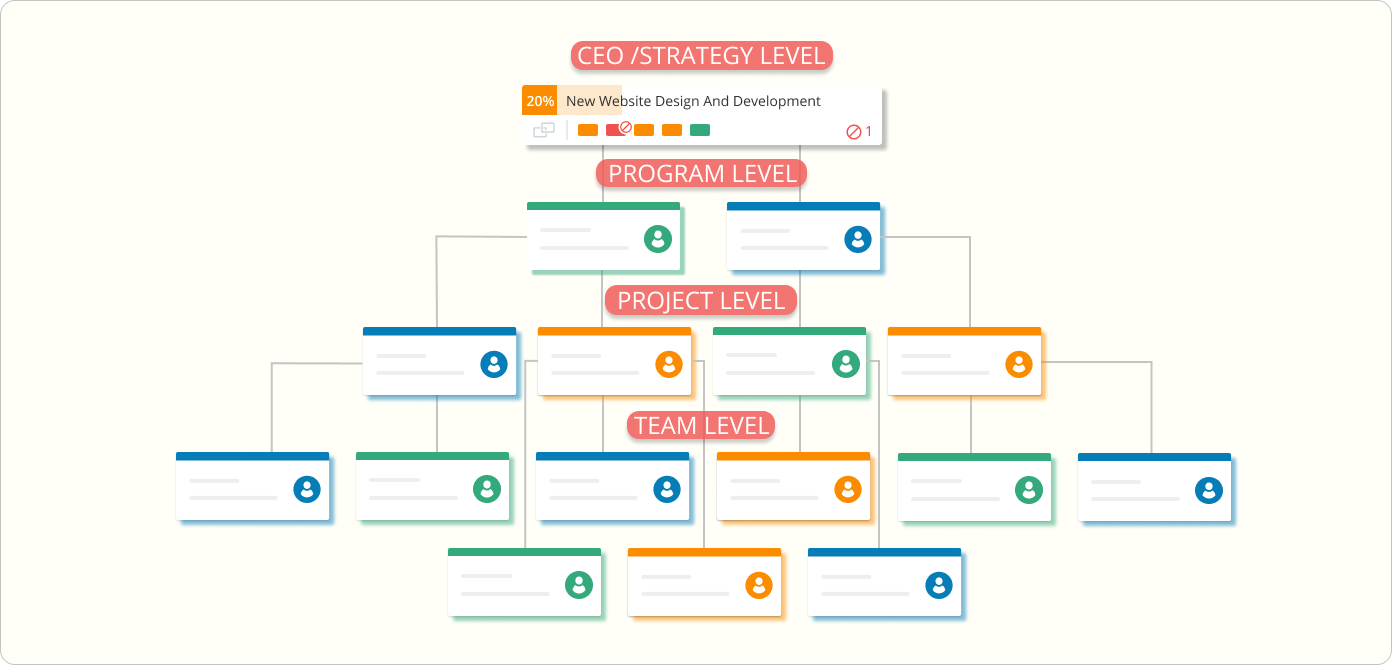
1. Connect Strategy, Portfolio, and Project Execution
As mentioned above, one of the main themes in Agile portfolio management is creating visibility inside the portfolio. This will allow you to maintain a shared understanding of the project's status and progress toward success. Ultimately, the idea is to bridge the gap between high-level planning and operations to execute your organization's strategy. In practice, strategic portfolio management can happen through the implementation of related Kanban boards. You can use them to visualize initiatives and themes , multiple projects, project deliverables, or individual tasks. Let's take a quick example with an R&D department inside an organization .

Visualizing a dedicated Portfolio Kanban board
Progressing down to lower levels, you can keep using related Kanban boards to visualize different parts of the department or even the entire organization. Those can be program or project management processes going all the way down to the individual tasks that team members are responsible for. The idea is to create a central hub and keep track of your portfolio without losing sight of its execution across multiple teams. In Businessmap, for example, we combine Management and Team Workspaces to visualize and connect project planning and daily operational activities across teams. This will allow you to achieve unmatched transparency over multiple projects.
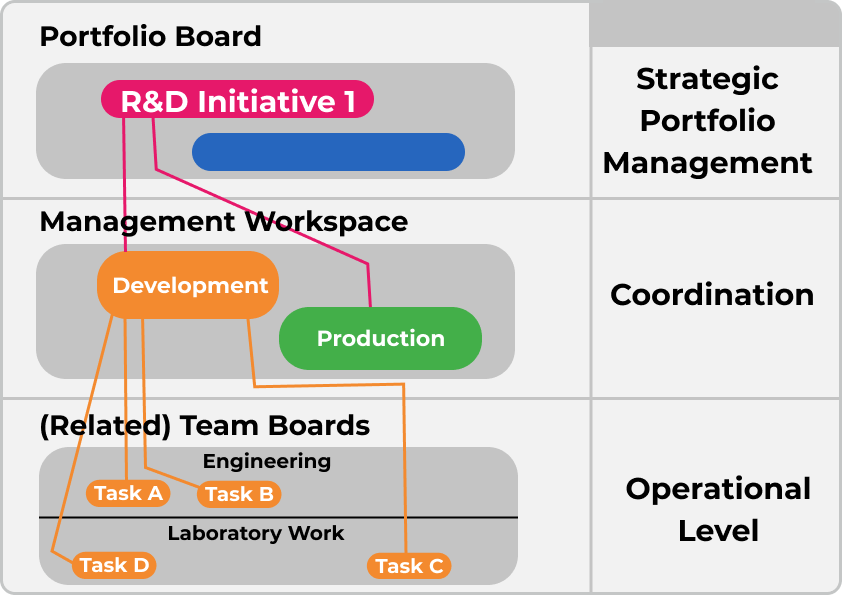
2. Manage the Portfolio Flow
Once you have your Portfolio Kanban board set up, another important part is managing the project flow from concept to fruition. In Kanban, we do that by mapping the value stream of all our processes . By implementing different commitment points, for example, you can signify the point in your process where a project has been committed for refinement, execution or it's ready for customer delivery.
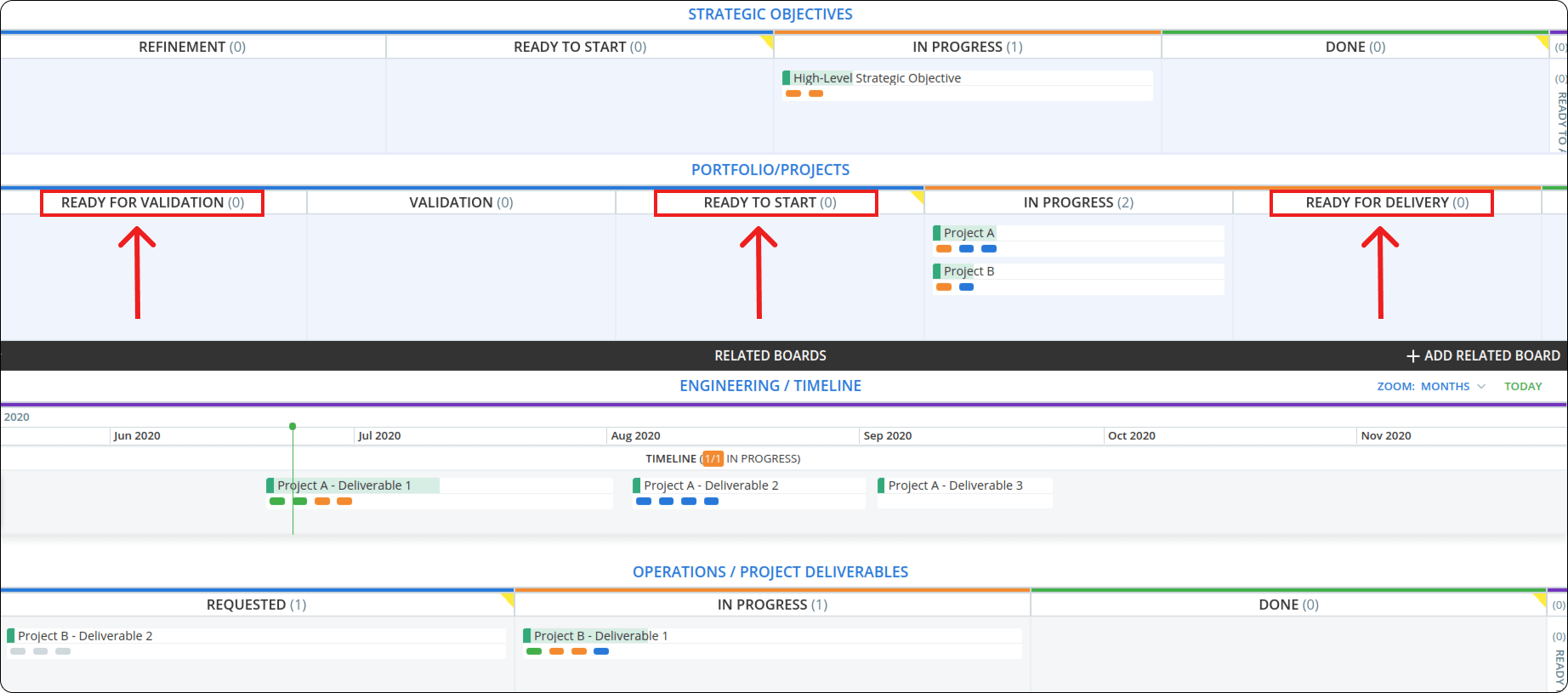
It's important to note the refinement part before the "Ready to Start" column on the Kanban board. This is essentially an Upstream Kanban process where each project request represents an option portfolio managers should validate before committing to execution. At this stage in the flow, you can buy some extra time to gather more details and make a proper decision about engaging or not in a project based on new data.
This is an excellent moment for running experiments to make reasonable decisions. Another best practice for managing portfolio flow is to limit projects in progress . Doing this will allow you to relieve your teams from overburdening and match the incoming demand with real capabilities. As a result, you will ensure that the team's attention is directed towards the most critical initiatives at any given moment, and this way, focus on improving your global throughput.

3. Review The Portfolio on a Regular Basis
Revisiting your portfolio of projects in a regular cadence is an integral part of Agile portfolio management. To do this, Kanban uses of feedback loops/ cadences on a portfolio level. The idea is to regularly review the status of the projects, products, or services in progress and engage in collaborative discussions with middle managers on things such as identified dependencies or risks, available capacity across the structure, and needs for shared resources. This input should be aggregated by lower-level cadences spanning multiple teams across a department or the entire organization.
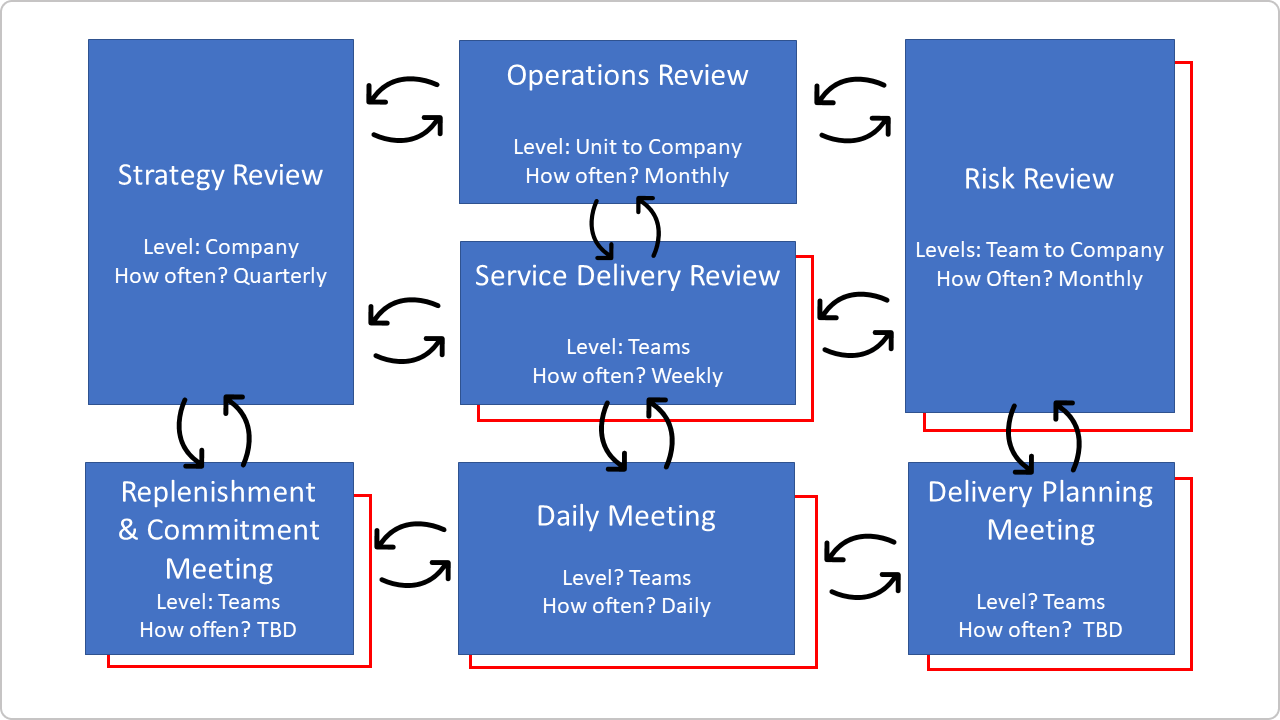
Applying a regular portfolio cadence within management meetings and using Portfolio Kanban boards to visualize what’s important allows managers to prioritize new projects and initiatives and sync whether they adapt with the company's strategy. Agile cadences at the portfolio level allow managers to adapt to strategic changes of direction and ensure that the right things are done at the right time.
4. Analyze Metrics for Continuous Improvement
Like everything else that turns into a success, Agile portfolio management also requires continuous improvement. That's why you need to have a way to collect data and analyze it to make better decisions. In a Kanban system, you can do that by measuring different Lean/ Agile metrics such as lead and cycle time, throughput, and WIP (Work in Progress). With the help of various charts such as Cycle Time Scatterplots , you can monitor when the projects inside your portfolio get done and with what time probability they are likely to flow through your system on average. This helps you spot outliers and emerging trends so you can take any necessary precautions or discuss improvements in the management process.

Furthermore, combining that data with a powerful technique such as Monte Carlo Simulations will allow you to make probabilistic forecasting based on historical data rather than estimations derived from a gut feeling. As a result, you will have a way to derive possible outcomes for the delivery of multiple projects inside your portfolio based on your team's real capabilities for executing them.
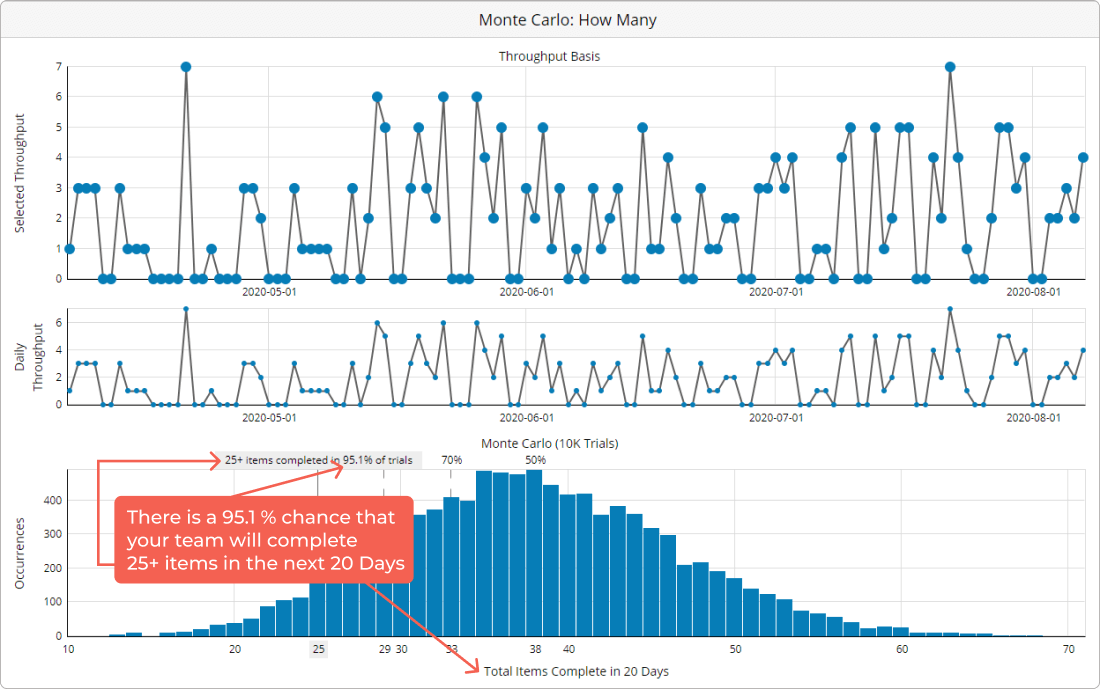
We offer the most flexible software platform
for outcome-driven enterprise agility.
Agile portfolio management is a more flexible way of managing a portfolio of projects, programs, initiatives, etc., by focusing on decentralized control, transparency, continuous experimentation, prioritization, and better alignment between strategy and execution. Building an effective Agile portfolio management process requires you to have a complete management system in place so you can:
- Bridge the gap between strategy, portfolio, and project execution;
- Manage portfolio flow;
- Engage in regular cadences/feedback loops (such as Portfolio Reviews) to adapt to changes;
- Analyze metrics and continuously improve.

Start your free trial now and get access to all features.
During the 14-day trial period you can invite your team and test the application in a production-like enviroment.
Jira Software
Project and issue tracking
Content collaboration
Jira Service Management
High-velocity ITSM
Visual project management
- View all products
Marketplace
Connect thousands of apps and integrations for all your Atlassian products
Developer Experience Platform
Jira Product Discovery
Prioritization and roadmapping
You might find helpful
Cloud Product Roadmap
Atlassian Migration Program
Work Management
Manage projects and align goals across all teams to achieve deliverables
IT Service Management
Enable dev, IT ops, and business teams to deliver great service at high velocity
Agile & DevOps
Run a world-class agile software organization from discovery to delivery and operations
BY TEAM SIZE
Small Business
BY TEAM FUNCTION
Software Development
BY INDUSTRY
Telecommunications
Professional Services
What's new
Atlassian together.
Get Atlassian work management products in one convenient package for enterprise teams.
Atlassian Trust & Security
Customer Case Studies
Atlassian University
Atlassian Playbook
Product Documentation
Developer Resources
Atlassian Community
Atlassian Support
Enterprise Services
Partner Support
Purchasing & Licensing
Work Life Blog
Support for Server products ends February 15, 2024
With end of support for our Server products fast approaching, create a winning plan for your Cloud migration with the Atlassian Migration Program.
Assess my options
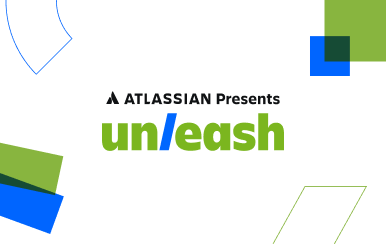
Atlassian Presents: Unleash
Product updates, hands-on training, and technical demos – catch all that and more at our biggest agile & DevOps event.
- Atlassian.com
Lean Portfolio Management
How to build a better enterprise by being more lean

Browse topics
The world is changing fast, and customer expectations are changing just as quickly. The pace of change has prompted enterprises to heavily invest in digital and agile transformations, where the benefits of agile teams are scaled and multiplied across the enterprise. But few organizations achieve the desired results. To realize the full value of an agile or digital transformation, business and technology teams must get aligned and stay aligned. A connected enterprise with full alignment is key to competing in the modern economy.
The challenge of connecting agile teams into an agile enterprise is that a gap emerges between the teams doing the work and the teams allocating the funding. To close this gap, leaders need the ability to:
- Gain visibility - Make the work visible in backlogs (for plans) and demos (for emerging solutions)
- Figure out what works - Review the incremental output to assess progress towards outcomes
- Optimize investments - Pivot or persevere by reallocating funds to maximize throughput of value
As businesses seek alignment and to stay aligned, they often find traditional methods of portfolio management are ineffective. Instead, many adopt Lean Portfolio Management practices to drive alignment across the entire organization.

What is Lean Portfolio Management?
Lean Portfolio Management (LPM) describes how senior leadership applies lean principles to connect strategy to execution. Portfolio management teams learn about an enterprise’s strategy and allocate a budget towards the execution of that strategy.
Like any portfolio, an LPM portfolio of investments is creatively determined and actively managed across the investment life cycle. The primary emphasis of LPM is to align agile development with business strategy, with a focus on driving the delivery of value to customers through the creation of products and solutions. Combining LPM with agile development practices offers a path to improving business agility.
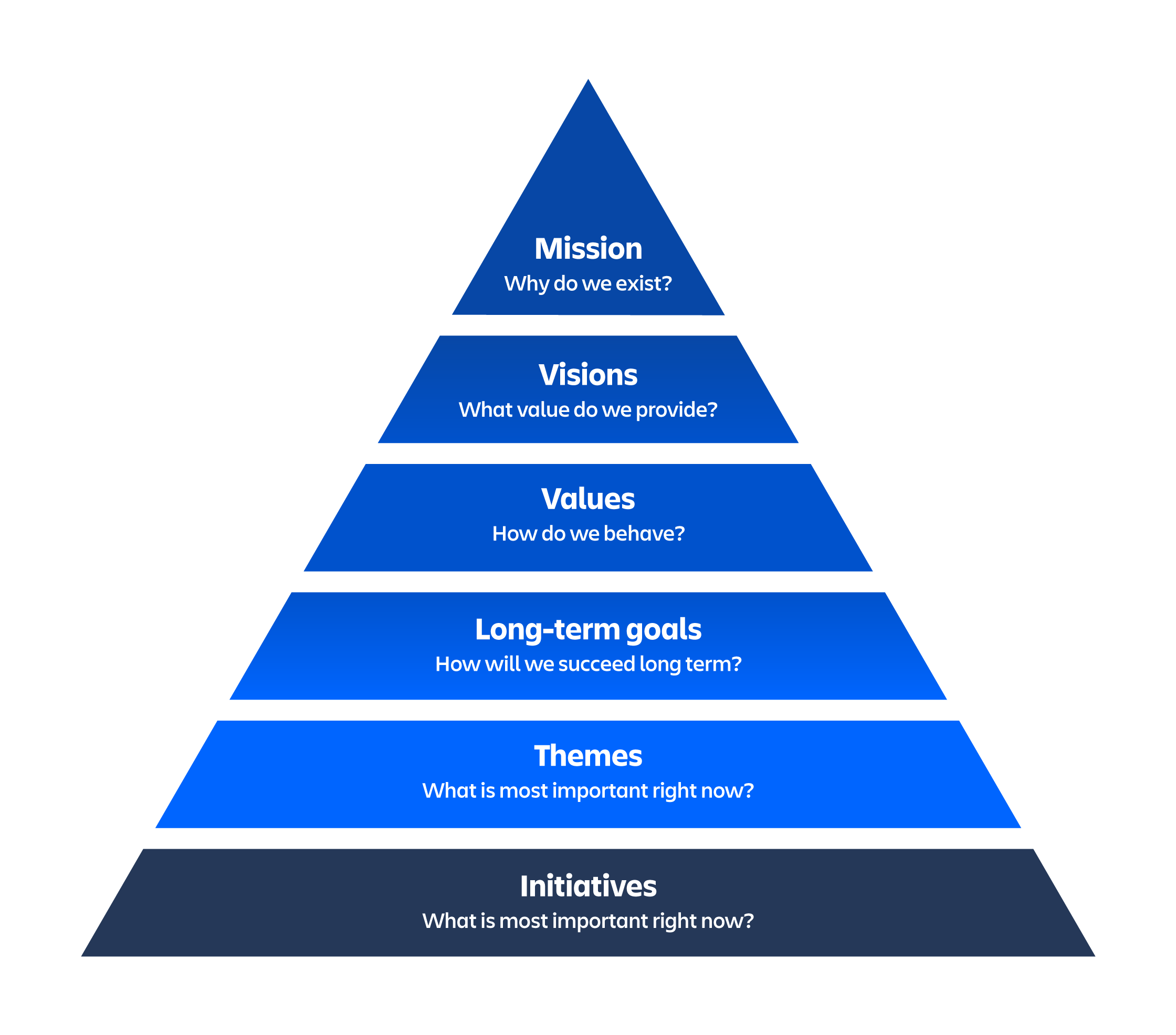
The objectives of Lean Portfolio Management are to:
- Maximize the throughput of value - Actively manage the backlog of investments to find the highest-value opportunities, and actively manage WIP across groups of teams(team-of-teams) to speed the delivery of value into the marketplace
- Prevent bottlenecks - Use the portfolio budget to balance the funding for capacity with the demand for the highest-value opportunities
- Demonstrate good servant leadership - Remove obstacles to keep delivery cycle times low
LPM differs from traditional project portfolio management in a number of ways, including:
- Bringing the work to the people not the people to the work
- Focusing on defining the desired outcomes, instead of the desired quantity of outputs
- Developing a definition of “value” and focusing more on value delivery than managing costs
- Revisiting past decisions and plans every quarter based on new feedback
- Managing budgets and finances quarterly instead of annually
While traditional Project Portfolio Management (PPM) focuses on creating a set of tightly structured project plans and building short-lived teams to execute those plans, LPM focuses on:
- Bringing loosely structured value opportunities to long-standing team-of-teams
- Asking teams to define the needed work
- Monitoring emerging solutions to iterate toward market fit
How portfolio management has evolved
Portfolio management leadership teams connect an organization’s strategy to its execution. But what does the portfolio consist of?
We’ve seen the term portfolio used in different ways:
- Funding is allocated to business leaders to build plans for their own development teams
- Funding is allocated to product leaders to build plans to execute their vision
- Funding is allocated to execute specific plans expected to yield specific outputs
- Funding is allocated to execute specific plans that are expected to yield specific improvements through IT
- Funding is allocated to team-of-teams that must use their resources to accomplish the initiatives
What do they have in common? Each has the ability to allocate funding, translate enterprise strategy into a local context, and govern execution and spending.
Over the last decade, some enterprise leaders have improved responsiveness and speed-to-market by shifting to portfolios of strategic initiatives implemented by team-of-teams. These successes formed the foundation of Lean Portfolio Management.
Why Lean Portfolio Management?
Organizations that focus on defining projects that span more than a year often get stuck in situations where teams are incentivized to meet out-of-date project goals, instead of delivering value early or seeking early feedback on market-fit. Lean portfolio management methods help organizations:
- Shift the operations focus to delivering incremental value at shorter cadences for larger initiatives.
- Leverage the cadences to achieve shorter feedback loops. Feedback collected via internal teams, external focus groups, customers, or end users helps measure progress towards the organization’s target outcomes.
- Ruthlessly apply the feedback to reinvest in ideas that produce good outcomes and downshift on ideas that do not.
Lean Portfolio Management, informed by lean principles and built through a better understanding of customer value (and how to deliver it quickly), remedies some common pain points in large organizations.
Pain point #1: Long cycle times on large initiatives.
- When organizations build autonomous, cross-functional teams, they remove handoffs and dependencies that add friction (and delays) to the delivery of value.
- When organizations improve their definition of customer value, communication improves and clears the path for the best ideas.
- When organizations emphasize a planning and execution model that yields continuous value flow, they strive to put value in customers' hands, instead of marking tasks as complete.
Pain point #2: Work gets done, but the key needles don’t move.
- When organizations define goals in terms of targeted business outcomes, they are more likely to “move the needle” on their key performance indicators (KPIs).
- When organizations evaluate those outputs in short feedback loops, they can quickly recalibrate short-term plans, based on what they see right now .
- When organizations set objective-based goals, captured as desired business outcomes, the incremental outputs can be evaluated against the desired business outcomes.
Pain point #3: Budgets are difficult to change based on new information.
- When organizations face a high amount of uncertainty in the marketplace, they can apply a lean start-up mindset to “think in bets.” In doing so, they can explore the solution space in a cost-effective way that funds small experiments, not large initiatives with substantial uncertainty.
- When organizations fund team-of-teams through agile budgeting, then empower them to build plans that align to strategic goals, the new distributed accountability model speeds up the overall delivery of value.
Key elements of Lean Portfolio Management
The lean portfolio leadership team sets the “north star” goal for the mission, funds the team-of-teams based on the enterprise’s strategic needs, then monitors the emergent plans and results to make sure they align to the strategic intent.
The leadership team makes decisions at a set cadence, and both the operations (activities they perform) and the governance (reviews that they hold) follow that cadence to synchronize and align the planning and feedback loops.
LPM operations
To continuously connect strategy to execution, the leadership team continuously assesses these targets:
Set mission
- Set (and recalibrate every quarter) the outcome-based objectives and strategic themes
Find opportunities
- Turn new ideas into investment candidates tied to the strategic mission
Target value delivery
- Build roadmaps based on market needs and the anticipated size of the effort, which should be collected during agile estimation and planning
Optimize for value
- Set clear priorities on the initiatives to (1) drive detailed planning for the next quarter, and (2) balance the roadmap against known capacity constraints
Check market fit
- “Go see” the incremental value delivered in the team demos and validate the value hypotheses
LPM governance
To achieve enterprise agility, the leadership team facilitates periodic reviews:
Strategy alignment review
- Once a quarter, confirm that the work aligns with the strategic intent
Portfolio budget review
- Once a quarter, confirm that the budget allocations funding the team-of-teams (and empowering their decentralized decision-making) is best supporting the mission
Portfolio team retrospective
- Once a quarter, look to improve the way that the portfolio leadership team operates, makes decisions, achieves continuous value flow
Portfolio financial review
- Once a month, compare the spending trends on the initiatives to the targets and guardrails to close the loop on agile budgeting
Portfolio roadmap review
- Once a month, share the updated initiative roadmap with all stakeholders
Investment opportunity review
- Once a week, approve funding for new investment opportunities based on their business case (or recalibrate past funding decisions based on new feedback)
How to implement Lean Portfolio Management
Adopting lean practices into existing portfolio leadership teams is a significant change and requires strong organizational change management practices. It often feels like renovating a house while you’re living in it—with similar levels of stress and satisfaction. To continue with this analogy, here are some tips for a lean home renovation:
- Find the owners - Portfolio leadership teams are high-performing, cross-functional teams of servant leaders. Unleashing the power of a leadership team is no less important than empowering a development team. The first step is to find and form the group that will connect strategy to execution for a specific part of the organization. That is the portfolio leadership team.
- Who is providing the funding to the portfolio? What are they expecting from it?
- Who provides the funding to “keep the lights” on (or run the business vs. change the business)?
- How many different, independently funded strategies will be driving the portfolio?
- Renovate - Even within the same organization, no two leadership teams will want to take exactly the same approach to agile portfolio operations. Discover the needs and expectations of the portfolio leadership team, including where they want to initially land between their current state and a (leaner) future state. Build an operating structure that embodies the key pieces of LPM, with a customized feel.
- Move back in - Recalibrate the active, funded work into leaner constructs that better support the flow of value, and consider using this opportunity to revisit the rationale for the work (pivot or persevere?). Lean encourages an organization to “maximize the work not done”. Can any active work be stopped or scaled back?
- Redecorate - LPM brings in new decision-making techniques, like the emphasis on visualizing strategic alignment of the work and “guardrail-based” governance. This drives the need to “re-instrument” existing work management systems to add new disciplines and additional clarity.
- Throw a party - Lean portfolio leadership teams make decisions and improvements at a set cadence. Surface positive feedback from retrospectives and make sure to celebrate the improved flow of value through the organization!
Lean Portfolio Management brings time-tested lean principles to the teams and leaders that are best positioned to drive organizational change. Overall, the lean approach drives reliable value delivery, reduces time to customer value, and ensures that teams can pivot as the marketplace changes or customer demands shift. Lean Portfolio Management offers a path to maximizing these advantages and building a more connected enterprise.
Interested in learning more about Lean Portfolio Management? Dive deeper into the fundamentals of LPM and see how Atlassian's Jira Align supports it.
John May is an enterprise solutions architect, product advisor, and thought leader for Atlassian. He has helped shape the Lean Portfolio Management offering in the Jira Align product, and brings over 20 years of experience in the software industry and scaled agile space. He enjoys helping leadership teams create a compelling path from their current state to a new, leaner way of working.
Agile Portfolio Management
Agile portfolio management helps large teams and developers efficiently manage projects. Read here to learn about high-functioning agile portfolios.
Scaled Agile Framework (SAFe) Values & Principles
The Scaled Agile Framework® (SAFe®) is a set of organization and workflow patterns for implementing agile practices at enterprise scale.
McKinsey & Company and Scrum.org Release Joint Research Study on Agile Teams
How to select and develop individuals for successful agile teams: a practical guide.
Boston – January 22, 2019– Today, McKinsey & Company , a global management consulting firm, and Scrum.org , the mission-based organization dedicated to improving the profession of software delivery through training, certification assessments and community, released a new research study titled, How to Select and Develop Individuals for Successful Agile Teams: A Practical Guide . This study explores the values and traits that make agile teams successful, helping to guide companies with concepts and ways to better recruit and coach their teams.
“We participated in this study with McKinsey & Company to better understand how organizations can improve their efforts to become more agile,” said Dave West, CEO & Product Owner, Scrum.org. “Agile organizations need to understand how to get, retain and enable the best talent, and this study provides guidance on how they can do so.”
The study looks at the personality traits and work values in two crucial roles for agile teams: The Product Owner and the Team Member, and subsequently covers effective methods of further developing a team’s agility. The findings suggest that the ability to handle ambiguity and agreeableness are most important among personality traits, whereas pride in product outcomes and self-direction are most important among work values. Additionally, the study suggests the importance of customer-centricity as a way to inspire agile teams. It also provides practical questions to support the interview process and good practices for developing agile teams.
“Prior to this study, Scrum.org and McKinsey predicted that the characteristics of types of people that lead to success in an agile team would differ from those in traditional work settings, and wanted to understand how information about how people become successful can help,” said Wouter Aghina, a partner in the McKinsey & Company Amsterdam office. “Understanding how to select and hire for this dynamic, agile future is critical to the team and organization.”
The results and details of the study will be discussed in further detail in a webinar with Dave West, Scrum.org and Wouter Aghina, McKinsey & Company, on February 26, 2019 at 12:00 PM EST. The details to register are here . The report based on the study can be accessed here .
About Scrum.org Based on the values and principles of Scrum and the Agile Manifesto, Scrum.org provides comprehensive training, assessments and certifications to improve the profession of software delivery. Throughout the world, our solutions and community of Professional Scrum Trainers empower people and organizations to achieve agility through Scrum. Ken Schwaber, the co-creator of Scrum, founded Scrum.org in 2009 as a global organization, dedicating himself to improving the profession of software delivery by reducing the gaps so the work and work products are dependable. Visit Scrum.org for further information on the organization’s Professional Scrum assessments, training and global community; follow us on Twitter @scrumdotorg and read more from our community of experts on the Scrum.org Blog .
About McKinsey & Company McKinsey & Company is a global management consulting firm, deeply committed to helping institutions in the private, public, and social sectors achieve lasting success. For more than 90 years, our primary objective has been to serve as our clients' most trusted external advisor. With consultants in 129 cities in 65 countries, across industries and functions, we bring unparalleled expertise to clients anywhere in the world. We work closely with teams at all levels of an organization to shape winning strategies, mobilize for change, build capabilities, and drive successful execution.
Media Contact: Lindsay Velecina Marketing Communications Manager Scrum.org [email protected]
The Burndown
Agile Portfolio Management
In a world where markets are increasingly unpredictable and subject to sudden disruption, companies need to be able to quickly shift resources among business units, products and individual initiatives. Portfolio Management is about ensuring that business resources are optimally invested to achieve the best possible business outcomes. The ability to quickly adapt is a key source of competitive advantage.
Portfolio Management Defined
- Deciding which initiatives to pursue, and their relative priorities.
- Deciding whether to continue, modify or cancel ongoing initiatives
A Portfolio Management Framework
Portfolio Management is the highest level planning process within an enterprise and includes the definition, refinement, prioritization, funding and ongoing management of in-flight initiatives. All of this requires a basic governance framework, the core elements of which should include:
- Portfolio Planning : Activities to identify, refine, prioritize and approve initiatives for execution.
- Portfolio Review : This is an event (or collection of events) to review and make adjustments (inspect & adapt) to in-progress initiatives.
- Portfolio Retrospective : Conduct retrospectives to continuously improve the framework over time.
Portfolio Planning
Each product or program or initiative in a portfolio serves some strategic objective. Organizations conduct analysis of their portfolios to determine priorities and investment levels. Strategy frameworks can be leveraged to help companies formulate a portfolio strategy. For example, McKinsey’s Three Horizons Model might be used to determine the appropriate investment mix. The model provides a framework that requires you to categorize your goals into 3 different ‘horizons’. The overall goal for is to build a pipeline of initiatives that keeps the company continuously supplied and refreshed with new sources of business. (More here).
- Horizon 1 : Maintain & Defend Core Business . Your goals in horizon 1 will be mostly around maintaining your revenue streams, reducing operating expenses, and improving existing processes.
- Horizon 2 : Nurture Emerging Business . Extending the core Horizon 1 business it into areas of emerging opportunity.
- Horizon 3 : Create Genuinely New Business . Introducing entirely new products or services to your business that don’t exist today. This may take the form of new products, services, or capabilities, that show great promise but are highly uncertain.
Refining the Portfolio Backlog
For Portfolio Planning, the establishment of a Portfolio Kanban can provide a method for defining business epics and a way to refine them to the point where they can be consumed by program teams. A Portfolio Kanban can be used to visualize the work, make status explicit, and limit work in progress (WIP) to ensure the focus is on getting individual epics to a Go/No-Go decision as quickly as possible. Different levels of epic refinement are reflected in a series of workflow states, each representing more detail than the previous one, until the final state (the Portfolio Backlog) contains those epics that are considered approved for investment and ready for consumption by program teams.
For consistency, a template should be established for epics. This template typically includes:
- An epic hypothesis or value statement (elevator-pitch style vision statement) – describing what are we building, who is it for, and why do they need it – See Geoffrey Moore’s Crossing The Chasm for details and examples.
- A set of core features, or scope definition. Its also helpful spell out what’s not in scope.
- A Minimum Viable Product (MVP) definition,
- A list of any architectural or technology enablers required to support the required features.
- A ranking level relative to other epics in the portfolio using WSJF (Weighted Shortest Job First). See Donald Reinertsen’s Principles of Product Development Flow for more on WSJF.
Epics that have achieved the above level of refinement are added to the portfolio backlog .
A portfolio Kanban system is an effective way to manage this process and track progress. The portfolio management team (epic owners and the enterprise architect) drives this process via regular portfolio management (or portfolio backlog refinement) meetings. For portfolio planning governance tasks include:
- Create/Review epic definitions
- Establish scope to meet MVP
- Identify architectural enablers
- Determine priorities, estimates and epic rankings (e.g. using WSJF)
- Update the Kanban board
The Kanban states needed for Portfolio Planning are:
- Funnel – initial state for all new ideas/proposals pending review and analysis
- Review – Epic defined in terms of epic value statement (elevator pitch-style vision statement) and in-scope, out-of-scope items defined.
- Analysis – One -page business case, solution alternatives, enablers, relative ranking (WSJF), and Go/No-Go decision on moving to the Portfolio Backlog. Strategy Tools like McKinsey’s Three Horizons, or the BCG Growth/Share Matrix might be used to support the analysis.
- Portfolio Backlog (Approved Epics)

Epic Ranking using WSJF
- WSJF = COD (Cost Of Delay)/Effort, where
- COD = Business Value + Time Criticality + Risk Reduction Opportunity
- Rank = COD/Effort
Scoring each parameter is done relative to other epics using the Fibonacci Series (1, 2, 3, 5, 8, 13, 20)

How To Calculate:
- Proceed column-by-column. Assign a score to each epic. Complete each column before starting the next one
- Make sure there is a “1” in each column, and score other epics relative to that one
- When done, if necessary adjust scores until rankings are unique
Some considerations/examples:
- Business Value: Highest scores should significantly move KPIs
- Time Criticality: For example, a regulatory deadline
- Risk Reduction: For example, a database upgrade that addresses a major security risk
Portfolio Review
Agile Portfolio Review means establishing the ability to quickly respond to change and make adjustments to the portfolio. Agility is based on the empirical pillars of transparency, inspection and adaptation. By adopting an agile approach, portfolio managers can mitigate financial risks and optimize their portfolios for maximum returns. Rapid decision-making requires lightweight artifacts that can be developed and maintained with minimum effort, and can provide a source of actionable data. The Portfolio Kanban continues to provide guidance for appropriate actions to be taken during the implementation stage of an epic.

Once implementation has begun on an epic, ongoing review is required in order to decide whether to continue development, modify or potentially terminate further development. During Portfolio Planning we conducted a basic business analysis and also ranked epics using WSJF. As epics are developed and incrementally deployed, factors affecting WSJF rankings will change, and at some point the value from further development will diminish.

Updated WSJF scoring should provide guidance on whether continued development makes business sense. Terminating further investment in an epic that has reached a point of diminishing returns creates value in the sense that it frees up resources for investment elsewhere. A regular (cadenced) portfolio review is needed to monitor updated epic WSJF rankings, together with other appropriate data such as OKRs, and to make decisions on whether to continue or pivot on epic development.

Similar Posts
Product roadmaps.
From Product Vision to Product Backlog Product Roadmaps are another potentially valuable tool for Product Owners and Product Managers. A roadmap communicates a plan or strategy for how the product will be evolved via a series of intermediate goals and milestones towards the Product Vision. These goals and milestones can be captured on a roadmap…

Better Backlogs from OKRs
Agile delivery, using frameworks like Scrum, starts with defining a Product Vision (called the Product Goal in Scrum). A Product Vision describes a future state of the product, and serves as a target for a Delivery Team to plan against. The Product Vision must then be elaborated into a Product Backlog – a prioritized list…
Linking Product Features to Business Value
In Scrum, every artifact (Product Backlog, Sprint Backlog, Product Increment) is intended to provide a focal point against which progress can be measured. The Scrum Guide tells us that just as everything in a Sprint Backlog should be contributing to a Sprint Goal, so everything in the Product Backlog should be supporting a Product Goal….
Vision, Strategy, Goals
Example: Tesla Company Vision (What we want to accomplish over the long term): “to create the most compelling car company of the 21st century by driving the world’s transition to electric vehicles.” Product Vision (What problem we want to solve for customers – Tesla Model 3): Bring sustainable transportation to the masses. Product Strategy (What is needed…
Product Goals And Sprint Goals
The latest version of the Scrum Guide introduces something called the Product Goal: The Product Goal describes a future state of the product which can serve as a target for the Scrum Team to plan against. The Product Goal is (reflected) in the Product Backlog. The rest of the Product Backlog emerges to define “what”…
From Projects to Product-Oriented Delivery
One of the most fundamental shifts when scaling agile delivery beyond single teams is transforming the way work gets done. This shift involves transitioning from temporary, project-based teams to a delivery model designed around product-oriented value streams that provide a pipeline of continuous value delivery to customers. A product-oriented operating model is a way of…
More From Forbes
How mckinsey embraces agile as key to managing talent.
- Share to Facebook
- Share to Twitter
- Share to Linkedin
Talent is now the determiner of business success, and agility is its philosophical underpinning, according to the interesting new book, Talent Wins: The New Playbook for Putting People First (HBRP, 2018) by Dominic Barton, the global managing partner of McKinsey & Company, and his colleagues Dennis Carey and Ram Charan.
As a result, talent needs to move to the very top of the CEO’s agenda. The book, along with the accompanying article, “ An agenda for the talent-first CEO ,” is a handbook specifically directed at CEOs and intended to help them do exactly this.
McKinsey on talent
Talent Transcends Strategy
In Talent Wins , we learn that the era “when strategy was paramount, organizations were designed for control, with little attention paid to the velocity of decision making or the agility needed to adjust on the fly to external changes” is over. Now CEOs need to realize that “talent is the value creator and therefore belongs at the top of its agenda… Agile organizations built around empowered teams are the best way to constantly and nimbly match the right talent to the right strategic initiatives.”
Now CEOs must put talent and finance on at least an equal footing, while recognizing that talent isn’t a thing that can be deployed like financial capital.
Deploying human capital is very different from deploying financial capital. Dollars and euros will go where you send them—and they won’t complain, of course. People, on the other hand, want to have a say in their fate. And at a time when talent is in such high demand, you must allow—and even encourage—people to have their say if you hope to attract the very best in your field. So, the successful deployment of talent is now largely a matter of creating an environment where the interests, ambitions, and innovations of people constantly shape the strategy and future of the company.
“The central premise of a talent-driven company,” says McKinsey, “is that talent drives strategy, as opposed to strategy being dictated to talent. The wrong talent inevitably produces the wrong strategy, and fails to deliver. Numbers like sales and earnings are the result of placing the right people in the right jobs where their talents flourish and they can create value that ultimately shows up in the numbers.”
The central question for the firm thus becomes: “How can we recruit, utilize, and develop people to deliver greater value to customers—and do so better than the competition?”
Behind The Rise Of Talent: The Power Of The Customer
Attracting the very best in the field is needed because of changes in the marketplace. The current marketplace is one in which each customer needs to be treated as a unique individual (what has been called N=1) This goes beyond mass customization or “a customer of one”: those are still business-centric views of the consumer. In the Copernican revolution in today’s management , the customer is the center of the commercial universe. The firm needs to have the capability of having interactive relationships with each customer and be involved in personalized, co-creation of experiences: as for example in Spotify’s Discover Weekly .
To win in this world, firms need to be able to generate instant, intimate, frictionless, interactive value at scale . Those that can’t won’t survive. And top performance will depend on top talent: the differential performance between the beginner and the expert may be as much as 1:100 in extreme cases and even 1:8 on average. Slow-moving top-down bureaucracies, or even meritocracies, simply won’t be able to keep up.
The battle for talent is being fought in part with astronomical compensation . “People who work at major tech companies or have entertained job offers from them have told The New York Times that specialists in artificial intelligence with little or no industry experience can make between $300,000 and $500,000 a year in salary and stock. Top names can receive compensation packages that extend into the millions.”
Yet money isn’t the whole ball game. Top talent is footloose and won’t stick around if they find themselves in an organization where the top management bosses them around and doesn’t listen to their ideas. In this world, the very word, “boss,” is a dirty word, particularly if the incumbent is not knowledgeable about the matter at hand—a frequent occurrence in today’s fast-moving, complex, high-tech environment.
The Talent-Driven Enterprise
How is a CEO to cope? Talent Wins suggests that the talent-driven enterprise must master four key elements.
- Design For Agility
“First, design your organization for agility. By agility, we mean the ability to adapt swiftly to the unpredictable trends that disrupt and reshape your industry… Facebook offers a good model. Its people work in teams that form and disband as occasion warrants. It offers alternative career paths and compensation that directly reward value creation.”
The book offers a capsule description of Agile management :
Structurally, more people are deployed in customer-facing teams while fewer people attend to centralized oversight of corporate profit, strategy, and direction. Major decisions become the responsibility of select, efficient, cross-functional committees, while the great majority of the rest are delegated to empowered teams and individuals. Where they can, these companies create signature processes that differentiate them from the competition, but they don’t try to prescribe the details of how their many teams get work done. The result is a company where employees know ‘this is how we do things around here,’ and yet feel empowered to come up with creative solutions to the rapidly evolving challenges they face.
McKinsey’s embrace of Agile isn’t simply following a fad. It flows from hard-headed financial reasons. In a related McKinsey report , we learn that “Agile units are over 1.5 times more likely to report higher performance compared to their competitors.”
- Think Platform, Not Structure
Second, firms should “think platform, not structure. This means replacing a fixed vertical hierarchy with an internal market that governs the deployment of talent….Traditional hierarchy gives way to a marketplace that provides talent and resources to a collection of small teams that cut across business lines and market segments.” Examples like Haier “may seem radical at first blush” but “many companies in many different industries can benefit from this kind of market-driven, fluid organization.”
- Make Work Meaningful
Third, McKinsey urges firms to “make work meaningful… It’s not just millennials who crave purpose at work. A sterile workplace will never capture the full potential of any truly creative person.” Without meaning, “you will never attract, and keep, the great talent that you need in order to thrive in our unpredictable economy.”
At firms like Facebook and Haier, “employees think solution before profit…. There’s an assumption—which has been borne out repeatedly by the marketplace—that excelling at the former will lead naturally to the latter. The solution-first approach reflects an appropriately modern, flexible understanding of how quickly marketplace dynamics can shift, and both companies have shown an admirable ability to pivot quickly.”
McKinsey also points to Gallup surveys which show that less than 30% of U.S. employees feel a strong connection to their company and work for it with passion. Worse, almost 20% of employees are actively disengaged and trying to undermine the company. These findings should be seen as sharp warning to any traditional manager: top talent isn’t going to stick around unless they see meaning in what they do.
- Understand Organizational Culture
Creating meaning will in turn depend on the organization’s culture. As CEO, you need to “understand your company’s social architecture, and measure and monitor it. This will be an ongoing concern, given that you’re never finished designing and redesigning the organization.”
McKinsey points to the need for very substantial progress in this area. Indeed, the C-suite itself recognizes its own shortcomings in dealing with people. According to a McKinsey survey of corporate directors, “Very few feel they are doing a good job developing people and ensuring that the company has a strong, healthy culture.” Moreover, they don’t have a good grasp of who’s adding value to the firm: according to a McKinsey study, “about 70% of senior executives are wrong about who is most influential in their organization.” In part, that’s because of what they spend their time on: most HR discussions at the board level concern “CEO succession and executive compensation.” Compensation committees don’t help much either: most “are noteworthy only when they overpay their CEO.”
Change is needed. “The compensation committee must evolve into a group focused on the recruitment, deployment, and development of talent.” It should be “given a new name, such as the talent and rewards committee, or perhaps the people committee.”
But it’s not just changing the name of a committee. It includes defining “social architecture as the set of norms guiding how work happens in an organization. Think of it as encompassing the ground rules for the processes and behaviors teams will use to turn ideas into value, a common vocabulary for everyone trying to work together toward a clearly understood goal. These rules should set the tone of debate and foster a mindset that supports constructive change.”
A Different Kind Of Organization
The result is likely to be startling to McKinsey’s CEO clientele. “Organizations that want talent to drive strategy will look radically differently from the hierarchical corporations of the past, the kind laden with multiple layers of managers”
Picture a leading multinational where employees decide for themselves which team they’d like to join, and which projects they’d like to attack. How about a company divided into some two hundred customer-facing units, each with its own pay scale and work methods, each so talent-driven that employees are given the right to fire their unit leader? These aren’t far-out fantasies: such companies exist today.
McKinsey gives detailed descriptions of Facebook and Haier.
The Case Of Facebook
MckKinsey cites Facebook as “a great example of a company built for agility.” The book recounts how CEO Zuckerberg led the shift from desktop to mobile. “He put mobile developers on every product team. As he explained to one financial analyst, ‘I told all of our product teams, when they came in for reviews: ‘Come in with mobile. If you come in and try to show me a desktop product, I’m going to kick you out. You have to come in and show me a mobile product.’’ Instead of struggling to adapt a legacy product, Facebook’s teams were unleashed to think first about creating great mobile products. New offerings emerged left and right, embodying the Facebook ethos of “move fast and break things.” Many never panned out… But many terrific ideas also flew up from the teams, and were implemented with speed and rigor. The overall result is astounding. By the end of 2016, mobile accounted for 84 percent of the company’s ad revenue. Annual revenue reached $27.6 billion, up from $7.8 billion in 2013.”
Agile management was key to the success. “Zuckerberg’s commitment and focus were critical to the turnaround. But without the team-based culture he had built over the years, Facebook might have gone the way of other erstwhile tech powerhouses, like Netscape and Yahoo. Managing a collection of empowered teams is complicated, but Facebook does it better than almost any other company.”
At Facebook, the talent doesn’t have to enter the ranks of management to advance in their career. The talent can keep boosting career (and pay) without ever moving onto the managerial ladder. There are in effect dual career tracks.
The Case Of Haier
At Haier, “CEO Zhang Ruimin is a visionary leader whose goal has always been to create a company that readily provides solutions to any problem that bedevils its customers (although Haier prefers to call them “users”). That’s a very different mindset from a CEO who thinks about his or her company simply as a manufacturer of products.”
McKinsey warns CEOs: “Haier CEO Zhang Ruimin once told reporters that large companies need to ‘lose control step-by-step.’ That sounds scary, but it’s a keenly perceptive description of how to optimize organizations in an era of constant change.”
’In the Internet era,’ he has explained, ‘every company must strive to eliminate the distance between the producer and the user.’ To do that, Zhang radically restructured Haier by breaking down the entire organization into around two thousand micro enterprises. CEO Zhang hasn’t just dismantled hierarchy, he’s turned the very concept on its head. In most companies, product decisions are made by managers at the top of the decision chain. At Haier, users drive the product decisions, and everything else flows from their choices. As radical as they are, the small and micros are in some ways merely the logical organizational representation of a philosophy that prizes user solutions above all else.
Challenges In Implementing Talent-Based Strategy
McKinsey notes three challenges for implementing a talent-based strategy. .
First, companies will have to become more courageous. Daring to be ambitious and to make mistakes and then to learn quickly from them will let companies redefine themselves and create a new and improved offer for their customers. Second, they must ensure the transformation is inclusive. Strong commitment from the top that is cascaded down through the organization, empowering all levels to deliver improvementsisessential. Finally, they must ensure the transformation goes far beyond technology. In our extensive experience – and backed up by our survey results – the biggest stumbling block to any transformation is usually the company’s culture. As an automotive OEM executive said: “The issue is not the organizational model, the issue is people and mindsets.
In short, the shift from a strategy-led company to a talent-first company requires fundamental changes in the way CEOs understand the very concept of management--the beginning of a new age.
The Copernican Revolution In Management
Why Agile is eating the world
Explaining Agile
Spotify’s Big Win: Discover Weekly
Can HR Become Agile?
Transforming HR: The Case Of Vistaprint

- Editorial Standards
- Reprints & Permissions
Smart cities: Digital solutions for a more livable future
Until recently, city leaders thought of smart technologies primarily as tools for becoming more efficient behind the scenes. Now technology is being injected more directly into the lives of residents. Smartphones have become the keys to the city, putting instant information about transit, traffic, health services, safety alerts, and community news into millions of hands.
After a decade of trial and error, municipal leaders are realizing that smart-city strategies start with people, not technology. “ Smartness ” is not just about installing digital interfaces in traditional infrastructure or streamlining city operations. It is also about using technology and data purposefully to make better decisions and deliver a better quality of life .
Quality of life has many dimensions, from the air residents breathe to how safe they feel walking the streets. The latest report from the McKinsey Global Institute (MGI), Smart cities: Digital solutions for a more livable future (PDF–6MB), analyzes how dozens of digital applications address these kinds of practical and very human concerns. It finds that cities can use smart technologies to improve some key quality-of-life indicators by 10 to 30 percent—numbers that translate into lives saved, fewer crime incidents, shorter commutes, a reduced health burden, and carbon emissions averted.
What makes a city smart?
Smart-city technologies have substantial unrealized potential to improve the urban quality of life, a look at current deployment in 50 cities around the world shows that even the most advanced still have a long way to go, smart cities change the economics of infrastructure and create room for partnerships and private-sector participation.

Smart cities put data and digital technology to work to make better decisions and improve the quality of life. More comprehensive, real-time data gives agencies the ability to watch events as they unfold, understand how demand patterns are changing, and respond with faster and lower-cost solutions.
Three layers work together to make a smart city hum (Exhibit 1). First is the technology base, which includes a critical mass of smartphones and sensors connected by high-speed communication networks. The second layer consists of specific applications. Translating raw data into alerts, insight, and action requires the right tools, and this is where technology providers and app developers come in. The third layer is usage by cities, companies, and the public. Many applications succeed only if they are widely adopted and manage to change behavior. They encourage people to use transit during off-hours, to change routes, to use less energy and water and to do so at different times of day, and to reduce strains on the healthcare system through preventive self-care.

MGI assessed how smart-city applications could affect various quality-of-life dimensions: safety, time and convenience, health, environmental quality, social connectedness and civic participation, jobs, and the cost of living (see interactive). The wide range of outcomes reflects the fact that applications perform differently from city to city, depending on factors such as legacy infrastructure systems and on baseline starting points.
Applications can help cities fight crime and improve other aspects of public safety
Deploying a range of applications to their maximum effect could potentially reduce fatalities (from homicide, road traffic, and fires) by 8 to 10 percent. In a high-crime city with a population of five million, this could mean saving up to 300 lives each year. Incidents of assault, robbery, burglary, and auto theft could be lowered by 30 to 40 percent. On top of these metrics are the incalculable benefits of giving residents freedom of movement and peace of mind.
Technology is not a quick fix for crime, but agencies can use data to deploy scarce resources and personnel more effectively. Real-time crime mapping, for instance, utilizes statistical analysis to highlight patterns, while predictive policing goes a step further, anticipating crime to head off incidents before they occur. When incidents do occur, applications such as gunshot detection, smart surveillance, and home security systems can accelerate law-enforcement response. But data-driven policing has to be deployed in a way that protects civil liberties and avoids criminalizing specific neighborhoods or demographic groups.
Seconds count when lives are at stake, making speed critical for first responders in getting to the scene of emergencies. Smart systems can optimize call centers and field operations, while traffic-signal preemption gives emergency vehicles a clear driving path. These types of applications could cut emergency response times by 20 to 35 percent. A city with an already low response time of eight minutes could shave off almost two minutes. A city starting with an average response time of 50 minutes might be able to trim that by more than 17 minutes.
Smart-city technologies can make daily commutes faster and less frustrating
Tens of millions of people in cities worldwide begin and end every workday fuming in traffic or piling into overcrowded buses and trains. Improving the daily commute is critical to quality of life.
By 2025, cities that deploy smart-mobility applications have the potential to cut commuting times by 15 to 20 percent on average, with some people enjoying even larger reductions. The potential associated with each application is highly variable, depending on each city’s density, existing transit infrastructure, and commuting patterns. In a dense city with extensive transit, smart technologies could save the average commuter almost 15 minutes a day. In a developing city with more grueling commutes, the improvement might be 20 to 30 minutes every day.
In general, cities with extensive, well-used transit systems benefit from applications that streamline the experience for riders. Using digital signage or mobile apps to deliver real-time information about delays enables riders to adjust their routes on the fly. Installing IoT sensors on existing physical infrastructure can help crews fix problems before they turn into breakdowns and delays.
Applications that ease road congestion are more effective in cities where driving is prevalent or where buses are the primary mode of transit. Intelligent syncing of traffic signals has the potential to reduce average commutes by more than 5 percent in developing cities where most people travel by bus. Real-time navigation alerts drivers to delays and helps them choose the fastest route. Smart-parking apps point them directly to available spots, eliminating time spent fruitlessly circling city blocks.
Cities can be catalysts for better health
The sheer density of cities makes them critical although currently underutilized platforms for addressing health. Recognizing that the role of technology in healthcare is broad and evolving by the day, we analyze only digital applications that offer cities room to play a role. We quantify their potential impact on disability-adjusted life years (DALYs), the primary metric used by the World Health Organization to convey the global disease burden, reflecting not only years of life lost to early death but also productive and healthy life lost to disability or incapacity. If cities deploy the applications included in our analyses to their fullest effect, we see the potential to reduce DALYs by 8 to 15 percent.
Applications that help prevent, treat, and monitor chronic conditions , such as diabetes or cardiovascular disease, could make the biggest difference in the developed world. Remote-patient-monitoring systems have the potential to reduce the health burden in high-income cities by more than 4 percent. These systems use digital devices to take vital readings, then transmit them securely to doctors in another location for assessment. This data can alert both patient and doctor when early intervention is needed, heading off complications and hospitalizations.
Cities can use data and analytics to identify demographic groups with elevated risk profiles and target interventions more precisely. So-called mHealth interventions can send out lifesaving messages about vaccinations, sanitation, safe sex, and adherence to antiretroviral therapy regimens. In low-income cities with high infant-mortality rates, data-based interventions focused on maternal and child health alone could reduce DALYs by more than 5 percent. Another 5 percent reduction is possible if developing cities use infectious-disease surveillance systems to stay a step ahead of fast-moving epidemics. Telemedicine, which provides clinical consultations by videoconference, can also be lifesaving in low-income cities with doctor shortages.
Smart cities can deliver a cleaner and more sustainable environment
As urbanization, industrialization, and consumption grow, environmental pressures multiply. Applications such as building-automation systems, dynamic electricity pricing, and some mobility applications could combine to cut emissions by 10 to 15 percent.
Water -consumption tracking, which pairs advanced metering with digital feedback messages, can nudge people toward conservation and reduce consumption by 15 percent in cities where residential water usage is high. In many parts of the developing world, the biggest source of water waste is leakage from pipes. Deploying sensors and analytics can cut those losses by up to 25 percent. Applications such as pay-as-you-throw digital tracking can reduce the volume of solid waste per capita by 10 to 20 percent. Overall, cities can save 25 to 80 liters of water per person each day and reduce unrecycled solid waste by 30 to 130 kilograms per person annually.
Air-quality sensors do not automatically address the causes of pollution, but they can identify the sources and provide the basis for further action. Beijing reduced deadly airborne pollutants by roughly 20 percent in less than a year by closely tracking the sources of pollution and regulating traffic and construction accordingly. Sharing real-time air-quality information with the public via smartphone apps enables individuals to take protective measures. This can reduce negative health effects by 3 to 15 percent, depending on current pollution levels.
Smart cities can create a new type of digital urban commons and enhance social connectedness
Community is hard to quantify, but MGI surveyed urban residents to determine if digital channels for communicating with local officials as well as digital platforms that facilitate real-world interactions (such as Meetup and Nextdoor) can have an impact. Our analysis suggests that using these types of applications could nearly double the share of residents who feel connected to the local community, and nearly triple the share who feel connected to local government.
Establishing channels for two-way communication between the public and local agencies could make city governments more responsive. Many city agencies maintain an active presence on social networks, and others have developed their own interactive citizen apps. In addition to disseminating information, these channels create vehicles for residents to report concerns, collect data, or weigh in on planning issues. Paris has implemented a participatory budget, inviting anyone to post project ideas and then holding online votes to decide which ones merit funding.
Would you like to learn more about the McKinsey Global Institute ?
Becoming a smart city is not a strategy for job creation, but smart solutions can make local labor markets more efficient and slightly lower the cost of living.
Many local officials want to know if becoming a smart city will lead to an infusion of high-paying tech jobs or accelerate a wave of automation. Our analysis finds a slightly positive net impact on formal employment. Smart technologies will directly eliminate some jobs (such as administrative and field jobs in city government) while creating others (such as maintenance, driving roles, and temporary installation jobs). E-career centers can have a modest positive impact by creating more efficient mechanisms for hiring and drawing more unemployed and inactive people into the workforce. Data-driven formal education and online retraining programs can enhance a city’s pool of skills. Digitizing government functions such as business licensing, permitting, and tax filing can free local enterprises from red tape, contributing to a more entrepreneurial business climate.
Many of the world’s most dynamic and desirable cities have serious housing shortages , driving up rents and home prices. Expanding the supply of housing can bring down those costs. In many places, bureaucracy bogs down land acquisition, environmental studies, design approvals, and permitting. Digitizing these processes can remove risks and delays, encouraging more construction. In addition, most cities have a surprising amount of land sitting idle that could be suitable for infill housing. Creating open-source cadastral databases can help to identify land parcels for development.
Smart applications produce savings in other areas, such as encouraging more efficient usage of utilities and the healthcare system. Products such as home-security systems, personal-alert devices, and lifestyle wearables involve consumer purchases, but they offer value that many are willing to pay for. Mobility applications offer new value as well, although e-hailing may encourage people to take more rides than they once did. However, e-hailing and other sharing applications make it possible for some people to forgo private vehicle ownership. MGI estimates that the average person could save as much as 3 percent on current annual expenditures.

MGI took a snapshot of deployment in 50 cities around the world, not to crown the world’s smartest city but to show the full sweep of activity under way around the globe. This includes assessment of each city’s technology base, its current application rollout, and public adoption.
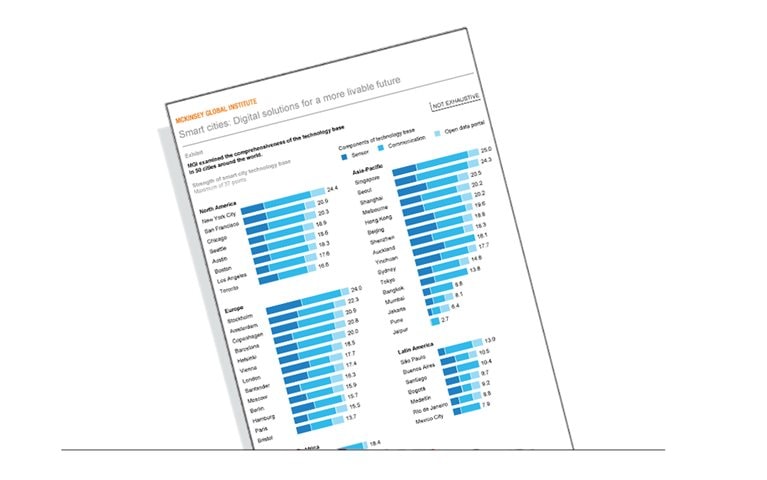
Download and print a smart-city snapshot showing deployment progress.
Our view of each city’s technology base looked at the extent of sensors and devices , the quality of communication networks, and the presence of open data portals. Among the most advanced are Amsterdam, New York, Seoul, Singapore, and Stockholm—but even these front-runners are only about two-thirds of the way toward what constitutes a fully comprehensive technology base today. In general, cities across China, East Asia, Europe, and North America have relatively strong tech bases, as do select cities in the Middle East. But those in Africa, India, and Latin America lag behind, particularly in installing the sensor layer, the most capital-intensive element.
We gauged each city’s progress in implementation using a checklist of current smart applications. Mobility has been a top priority for most cities, but those places with the highest number of applications implemented overall—London, Los Angeles, New York, Seoul, Shenzhen, and Singapore—have branched out into multiple domains. Some cities have not yet implemented the applications with the greatest potential to address some of their priority issues.
MGI conducted online surveys in all of the cities analyzed to gauge how residents feel about the technologies already at work in their environment. We found that Asian cities are the strongest performers in awareness, usage, and satisfaction, while European cities lag. Positive adoption and awareness appear correlated with having a young population that not only accepts a more digital way of doing things but also expects it.

Smart-city technologies help cities get more out of their assets, whether they have extensive legacy systems or are building from scratch. There is no getting around the need to invest in physical assets and maintenance, but smart technologies can add new capabilities as core components are upgraded.
Infrastructure investment once locked cities into capital-intensive and extremely long-term plans. Now, using the right combination of traditional construction and smart solutions, they can respond more dynamically to how demand is changing. If population growth surges in a far-flung neighborhood, adding a new subway or bus line with the accompanying fleet expansion may take years. By contrast, a privately operated on-demand minibus service could be up and running much faster.
City government does not have to be the sole funder and operator of every type of service and infrastructure system. While implementing most of the applications that we examined would fall to the public sector, the majority of the initial investment could come from private actors (Exhibit 2). Public financing may be reserved for only those public goods that must be provided by the government. Furthermore, more than half of the initial investment that needs to be made by the public sector would generate a positive financial return, which opens the door to partnerships .
Adding more actors to the mix is a positive, since it increases adoption and applies more creativity to the available data. When private-sector innovations spring up organically, the role of government may involve regulating, convening key actors, offering subsidies, or changing purchasing decisions. Rather than taking a master-planning approach, some cities position themselves as ecosystems, creating consortia and even physical collaboration spaces.
Some cities are starting their transformations with inherent advantages such as wealth, density, and existing high-tech industries. But even places that lack these ingredients can set themselves apart with vision, good management, a willingness to break with conventional ways of doing things, and a relentless commitment to meeting the needs of residents. There are many blank canvases for the private sector, not for profits, and technologists to fill—and above all, individuals should be empowered to shape the future of the cities they call home.
Stay current on your favorite topics
Lola Woetzel is a senior partner in McKinsey’s Shanghai office and a director of the McKinsey Global Institute; Jaana Remes is a partner in the San Francisco office; Brodie Boland is an associate partner the Washington, DC, office, where John Means is a partner; Katrina Lv is a partner in the Shenzhen office; Suveer Sinha is a partner in the Mumbai office; Gernot Strube is a senior partner in the Munich office; Jonathan Law is a partner in the New York office; Andrés Cadena is a partner in the Bogotá office; and Valerie von der Tann is a consultant in the Berlin office.
Explore a career with us
Related articles.

Urban world: Meeting the demographic challenge in cities

Bridging infrastructure gaps: Has the world made progress?

Urban commercial transport and the future of mobility

IMAGES
VIDEO
COMMENTS
Divesting with agility. Recent McKinsey research revealed that, over a ten-year-period, companies that regularly refreshed between 10 percent and 30 percent of their portfolio through acquisitions and divestitures outperformed the market by about 5 percent. 1. There is value in a proactive approach to asset reallocation.
How to divest with agility | McKinsey. In business, breaking up is hard to do. While divesting businesses in a timely manner is an essential aspect of effective portfolio management, companies tend to struggle with separation decisions. In this episode of the Inside the Strategy Room podcast, three experts discuss how to determine which ...
Agile companies create transparency into portfolio performance and have the flexibility to shift priorities and talent through a quarterly business review (QBR) process. 3 For more on the quarterly business review process, see McKinsey Organization Blog, "Quarterly Business Review: How to extract benefits beyond transparency," blog entry by ...
The data-analytics solution for simplifying complex product portfolios | McKinsey. Managing a product portfolio is a tricky business at the best of times. There's a constant tension between product development and its desire to create new things, operations and its focus on costs and complexities, and sales with its need to cater to customer ...
There are many different paths to enterprise agility. Some organizations are born agile—they use an agile operating model from the start. As for others, broadly put, we see three types of journeys to agile: All-in, which entails an organization-wide commitment to go agile and a series of waves of agile transformation; Step-wise, which involves a systematic and more discreet approach; and ...
The journey to agile: How companies can become faster, more productive, and more responsive. October 5, 2020 -. Agile operating models are characterized by rapid learning and decision-making cycles. Here's how organizations can use agile practices to transform their organizations.
The most successful companies running agile at scale share three common traits. First, the entire program is iterative. Traditional portfolio management is focused on top-down planning with work laid out over long time periods, but agile portfolio management takes the concept of build-measure-learn cycles used by individual agile teams and applies it on a larger scale.
Comprising about 350 nine-person "squads" in 13 so-called tribes, the new approach at ING has already improved time to market, boosted employee engagement, and increased productivity. In this interview with McKinsey's Deepak Mahadevan, ING Netherlands chief information officer Peter Jacobs and Bart Schlatmann, who, until recently, was the ...
The McKinsey Podcast, our new flagship podcast series, takes you inside our global firm, and features conversations with experts on issues that matter most in business and management. McKinsey & Company is a management-consulting firm that helps businesses, governments, and not-for-profit organizations realize their most important goals.
Agile portfolio management refers to applying Agile principles and practices to manage a portfolio of projects. It involves aligning strategy and execution, improving transparency across a portfolio of projects, and embracing cross-team collaboration and continuous improvement. Adopting Agile principles to portfolio management has been a trend ...
For example, according to a McKinsey study, 93% of business units that had fully adopted an agile model prior to the COVID-19 crisis, outperformed those that had not. Benefits of Agile Portfolio ...
The management team then sought to rebalance the portfolio toward bolder, higher-NPV initiatives, including bottom-up product redesigns to reduce the time to market. After reallocating resources to projects with higher commercial potential, the company saw a threefold increase in revenue and reduced the time to market for new products by nearly ...
The objectives of Lean Portfolio Management are to: Maximize the throughput of value - Actively manage the backlog of investments to find the highest-value opportunities, and actively manage WIP across groups of teams (team-of-teams) to speed the delivery of value into the marketplace. Prevent bottlenecks - Use the portfolio budget to balance ...
4e include in our sense of agile the idea—coined in the work of Nicholas Taleb—that this is "anti-fragile." W 5 Michael Bazigos, Aar on De Smet, and Chris Gagnon, "Why agility pays," McKinsey Quarterly, December 2015. Exhibit 1 The agile organization is dawning as the new dominant organizational paradigm.
Step 1: Define the lean portfolio management function. The focus areas of the LPM function include strategy and investment planning, lean governance and agile operations. PPM leaders should identify the right talent for each focus area, having the respective expertise in: Ensuring the entire portfolio is aligned and funded to meet business targets.
Agile portfolio management (APM) also assists organizations in making efficient resource allocation decisions. It will keep resources from leaking out. Agile portfolio planning also helps teams anticipate performance issues and implement necessary measures on time. For all these reasons, businesses should incorporate agile portfolio management.
Agile Equity Portfolio Management applies the principles of agile development to managing an equity portfolio, including division of labor, process design, and project management tools.
The results and details of the study will be discussed in further detail in a webinar with Dave West, Scrum.org and Wouter Aghina, McKinsey & Company, on February 26, 2019 at 12:00 PM EST. The details to register are here. The report based on the study can be accessed here. Based on the values and principles of Scrum and the Agile Manifesto ...
Agile Portfolio Management. In a world where markets are increasingly unpredictable and subject to sudden disruption, companies need to be able to quickly shift resources among business units, products and individual initiatives. Portfolio Management is about ensuring that business resources are optimally invested to achieve the best possible ...
The McKinsey Agile Tribe, a group of over 50 global experts from various disciplines, see the old project management paradigm as treating organizations like machines. This paradigm still follows project management principles introduced by Henry Ford a century ago and continued by Henry Gantt. The digital revolution that has started to shape new ...
McKinsey's embrace of Agile isn't simply following a fad. It flows from hard-headed financial reasons. In a related McKinsey report, we learn that "Agile units are over 1.5 times more likely ...
Reflecting the need for action, end-to-end margin management was identified as a top three priority by 87 percent of participants in our recent Procurement Executive Forum. 8. Redefine portfolio and product design. Reevaluate offerings to identify those that rely heavily on scarce materials and few suppliers.
McKinsey & Company is an American multinational strategy and management consulting firm that offers professional services to corporations, governments, and other organizations. Founded in 1926 by James O. McKinsey, McKinsey is the oldest and largest of the "Big Three" management consultancies (MBB).The firm mainly focuses on the finances and operations of their clients.
Agile Business Solutions Solutions for Agile Teams ... Article Agile, Portfolio Management, SCRUM 1 December 2018 . Project Management Journal. ... Per We evaluate what has already happened in the field of project portfolio management (PPM) and what will most likely shape the future. Article Portuguese Articles, Agile 1 May 2021 ...
Smart cities put data and digital technology to work to make better decisions and improve the quality of life. More comprehensive, real-time data gives agencies the ability to watch events as they unfold, understand how demand patterns are changing, and respond with faster and lower-cost solutions. Three layers work together to make a smart ...
On the business side, it can help stakeholders frame discussions about the importance of specific product features when choosing a software vendor. On the IT side, the MoSCoW method plays an important role in Agile project management by helping project teams prioritize story points.